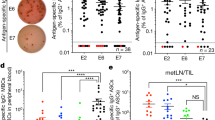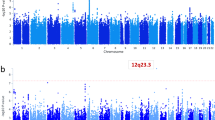Abstract
HLA-restricted cytotoxic T-lymphocyte (CTL) recognition of human papillomavirus (HPV) oncogene products may be important in the control of the HPV infections associated with the development of cervical cancer. We have identified, in HLA-B7 individuals, a consistent variation in the HPV16 E6 oncoprotein sequence, which alters an HLA-B7 peptide binding epitope in a way likely to influence immune recognition by CTLs. These results illustrate a biologically relevant mechanism for escape from immune surveillance of HPV16 in HLA-B7 individuals. Thus, both HLA type and HPV16 strain variation need to be considered in the screening of at-risk individuals and for the rational design of anti-HPV vaccines.
This is a preview of subscription content, access via your institution
Access options
Subscribe to this journal
Receive 12 print issues and online access
$209.00 per year
only $17.42 per issue
Buy this article
- Purchase on Springer Link
- Instant access to full article PDF
Prices may be subject to local taxes which are calculated during checkout
Similar content being viewed by others
References
Zur Hausen, H. Human papillomavirus in the pathogenesis of anogenital cancer. Virology 184, 9–13 (1991).
Koutsky, L.A. et al. A cohort study of the risk of cervical intraepithelial neoplasia grade 2 or 3 in relation to papillomavirus infection. New Engl. J. Med. 327, 1272–1278 (1992).
Lorincz, A.T. et al. Temporal associations of human papillomavirus infection with cervical cytologic abnormalities. Am. J. obstet. Gynecol. 162, 645–651 (1990).
Brinton, L.A. Epidemiology of cervical cancer — overview. in Epidemiology of Cervical Cancer and Human Papillomavirus (eds Munoz, N., Bosch, F. X., Shah, K. V. & Meheus, A.) 3–23 (IARC, Lyon, 1992).
Wank, R. & Thomssen, C. High risk of squamous cell carcinoma of the cervix for women with HLA-DQw3. Nature 352, 723–725 (1991).
Glew, S.S., Stern, P.L., Davidson, J.A. & Dyer, P.A. HLA antigens and cervical carcinoma. Nature 356, 22 (1992).
Helland, Å., Børresen, A.L., Kaern, S., Rønningen, K.S. & Thorsby, E. HLA antigens and cervical carcinoma. Nature 356, 23 (1992).
Han, R., Breitburd, F., Marche, P.N. & Orth, G. Linkage of regression and malignant conversion of rabbit viral papillomas to MHC class II genes. Nature 356, 66–68 (1992).
Apple, R.J. et al. HLA DR-DQ associations with cervical carcinoma show papillomavirus-type specificity. Nature Genet. 6, 157–162 (1994).
Pirisi, L., Yasumoto, S., Feller, M., Doniger, J. & DiPaolo, J.A. Transformation of human fibroblasts and keratinocytes with human papillomavirus type 16 DNA. J. Virol. 61, 1061–1066 (1987).
Sadovnikova, E. et al. Limitations of predictive motifs revealed by cytotoxic T lymphocyte epitope mapping of the human papilloma virus E7 protein. Int. Immun. 6, 289–296 (1994).
Townsend, A. et al. The epitopes of influenza nucleoprotein recognised by cytotoxic T lymphocytes can be defined with short synthetic peptides. Cell 44, 959–968 (1986).
Falk, K., Rotzschke, O., Stevanovic, S., Jung, G. & Rammensee, H-G. Allele-specific motifs revealed by sequencing of self-peptides eluted from MHC molecules. Nature 351, 290–296 (1991).
Keating, P.J. et al. Frequency of downregulation of individual HLA-A and-B alleles in cervical carcinomas in relation to TAP-1 expression. Br. J. Cancer, (in the press).
Honma, S. et al. Biological-clinical significance of selective loss of HLA-class-1 allelic product expression in squamous-cell carcinoma of the uterine cervix. Int. J. Cancer 57 650–655 (1994).
Cerundolo, V. et al. Presentation of viral antigen controlled by a gene in the major histocompatability complex. Nature 345, 449–452 (1990).
Elvin, J., Potter, C., Elliot, T., Cerundolo, V. & Townsend, A. A method to quantify binding of unlabelled peptides to Class 1 MHC molecules and detect their allele specificity. J. immunol. Methods 158, 161–171 (1993).
Huczko, E.L. et al. Characteristics of endogenous peptides eluted from the class 1 MHC HLA-B7 determined by mass spectrometry and computer modelling. J. Immun. 151, 2572–2587 (1993).
Maier, R. et al. Peptide motifs of HLA-A3,-A24, and -B7 molecules as determined by pool sequencing. Immunogenetics 40, 306–308 (1994).
Engelhard, V.H. et al. Mass spectrometric analysis of peptides associated with the human class 1 MHC molecules HLA-A2. 1 and HLA-B7 and identification of structural features that determine binding. Chem. Immun. 57, 39–62 (1993).
Bartholomew, J. et al. Identification of a naturally processed HLA-A0201-restricted viral peptide from cells expressing human papillomavirus type 16 E6 oncoprotein. Eur. J. Immunol. 24, 3175–3179 (1994).
Crook, T., Tidy, J.A. & Vousden, K.H. Degradation of p53 can be targeted by HPV E6 sequences distinct from those required for p53 binding and trans-activation. Cell 67, 547–556 (1991).
Klenerman, P. et al. Cytotoxic T-cell activity antagonized by naturally ocurring H1V-1 Gag variants. Nature 369, 403–407 (1994).
Bertoletti, A. et al. Natural variants of cytotoxic epitopes are T-cell receptor antagonists for antiviral cytotoxic T-cells. Nature 369, 407–410 (1994).
Gavioli, R. et al. Multiple HLA A11-restricted cytotoxic T-lymphocyte epitopes of different immunogenicities in the Epstein-Barr virus-encoded nuclear antigen 4. J. Virol. 67 1572–1578 (1993).
Burrows, S.R., Sculley, T.B., Misko, I.S., Schmidt, C. & Moss, D.J. An Epstein-Barr virus specific cytotoxic T-cell epitope in EBV nuclear antigen 3 (EBNA 3). J. exp. Med. 171, 345–352 (1990).
Phillips, R.E. et al. Human immunodeficency virus genetic variation that can escape cytotoxic T-cell recognition. Nature 354, 453–459 (1991).
Hill, A.V.S. et al. Molecular analysis of the association of HLA-B53 and resistance to severe malaria. Nature 360, 434–439 (1992).
Madden, D.R., Gorga, J.C., Strominger, J.L. & Wiley, D.C. The three dimensional structure of HLA-B27 at 2.1 A resolution suggests a general mechanism for tight peptide binding to MHC. Cell 70, 1035–1048 (1992).
Ellis, S.A., Taylor, C. & McMichael, A. Recognition of HLA-B27 and related antigens by a monoclonal antibody. Hum. Immun. 5, 49–59 (1982).
Hill, A. et al. Characterisation of two Epstein-Barr virus epitopes restricted by HLA-B7. Eur. J. Immun. 25, 18–24 (1995).
Barnstaple, C.J. et al. Production of monoclonal antibodies to group A erythrocytes, HLA and other human ceil surface antigens — new tools for genetic analysis. Cell 14, 9–20 (1978).
Garrido, F. et al. Natural history of HLA expression during tumour development. Immun. Today 14, 491–499 (1993).
Author information
Authors and Affiliations
Rights and permissions
About this article
Cite this article
Ellis, J., Keating, P., Baird, J. et al. The association of an HPV16 oncogene variant with HLA-B7 has implications for vaccine design in cervical cancer. Nat Med 1, 464–470 (1995). https://doi.org/10.1038/nm0595-464
Received:
Accepted:
Published:
Issue Date:
DOI: https://doi.org/10.1038/nm0595-464
This article is cited by
-
Identification and validation of immunogenic potential of India specific HPV-16 variant constructs: In-silico & in-vivo insight to vaccine development
Scientific Reports (2015)
-
Analysis of mutations in the E6 oncogene of human papillomavirus 16 in cervical cancer isolates from Moroccan women
BMC Infectious Diseases (2013)
-
Rare human papillomavirus 16 E6 variants reveal significant oncogenic potential
Molecular Cancer (2011)
-
HLA-B*6701 as a subtype performing post-selected marking gene for cervical cancer
Wuhan University Journal of Natural Sciences (2010)
-
Entire genome characterization of human papillomavirus type 16 from infected Thai women with different cytological findings
Virus Genes (2009)



